Interest in larger diameter Pneumatic Capsule Pipelines grew again during the 1960s. The revival of interest in PCPs started as a growth in interest in high speed ground transportation. Over a 20 year period, teams from around the world greatly advanced PCP technology. Unfortunately they were only marginally more successful at finding applications for the technology than the Victorians had been 100 years before.
Hamburg
A twin bore PCP system for moving mail between the main post office and the main railway station in Hamburg was constructed during 1962 [1/2]. The system carried 1.6m long containers/capsules through 0.45m diameter tubes laid under the streets of the city. Capsules moved through the 1.8km long system at speeds of between 30 and 36km/h. It was reported to have worked reasonably well, attracting the attentions of the Belgium and French postal authorities, the later of which even went as far as to develop prototypes in the late 1960s. The Hamburg system seems to have been closed in 1973 [2]. The Hamburg systems was in many ways an oddity for the period, since it used much the same technology as the Victorians had, albeit with more modern materials.
Developing Modern Large Diameter PCP Technology
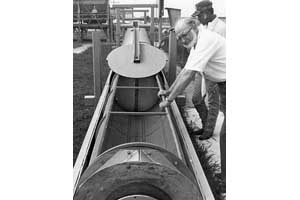
The first Tubexpress prototype system, constructed in Georgia, USA. Dr. Carstens is seen on the right of the picture (Source: Tubexpress).
Interest in larger diameter PCPs grew again during the 1960s. Round ([3]) suggests the revival of interest in PCPs started as a growth in interest in high speed ground transportation. The concept of high speed tube transportation was developed, with PCP being one technology potentially capable of delivering this.
Dr M. Carstens, working at the Georgia Institute of Technology is widely attributed with the invention of the 'jet pump injector', or booster pump within PCP systems [4]. A. Alexandrov of the Russian 'Special Design Bureau' independently researched similar technology at around the same time.
Carstens constructed a prototype at Stocksbridge, Georgia in 1971, sponsored by TRANSCO of Houston. A second prototype was constructed at Houston in 1973. Both systems were known as 'Tubexpress', although the diameter of the tube used in the second prototype (16") was much smaller than that used in the first (36") [5]. The later system was more obviously designed for bulk mineral transport application, with prototype loading and unloading facilities. It seems Carstens initially intended the system to be applied more generally to freight transport, including parcels [4].
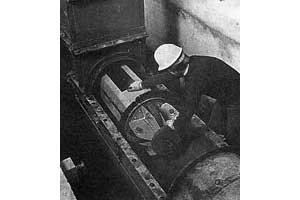
A capsule being loaded into the experimental BHRA system at Cranfield, England (Source: BHRA).
The British Hydromechanics Research Association (BHRA), based at Cranfield in England, conducted work in the field during the 1970s. Initially this was of a theoretical nature, addressing both engineering and economic aspects of PCP [6/7]. A 550m long, 60cm diameter test pipeline loop was put into operation in November 1976 and remained in use till March 1979, when the lease on the land the pipeline occupied ran out. The test facility built to demonstrate and refine performance of the booster valve, obtain performance data, and evolve capsule design, evaluate suitability of different materials for pipe [8]. The project was largely supported by the national government and nationalised industries such as British Steel, although there was some private commercial involvement [9]. Immediately prior to closure of the test facility, a non-stop 7,500km test was conducted, in which the capsule reached an average speed 12 m/s. Even once this test had been completed the capsule did still not need any essential maintenance. The British Technology Group was involved in marketing the technology. The William Press Group was involved in developing the technology further, possibly in Australia, although this seems not to have resulted in any tangible developments.
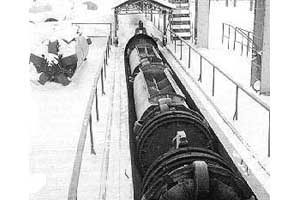
A Transprogress system near Tula, Russia (Source: Expo '86).
The first Russian 'Transprogress' system was designed for the movement of crushed rock. The system used trains of several container capsules and a 'pneumatic mover' (designed to brake the train during loading and unloading, and to provide a seal against air flow). Capsules were mounted on clusters of rubber tyred wheels. A 1020mm diameter system was constructed near Tibilisi in Georgia in November 1971. Capsules moved along the 2.1km long pipeline at speeds of 30km/h (loaded) or 50 km/h (unloaded) [10]. A single train, made up of six capsules, used the system, the train having a load capacity of 15 tonnes. The system could carry 0.4 million tonnes per annum. The system was designed by SKB Transnefteavtomatika and constructed by the Institute Giprovodkhoz. A system based on similar techniques, albeit using 180mm diameter pipes was implemented within a Moscow manufacturing plant, named Start. This was used for moving unspecified manufactured products from the workshops to storage areas [10].
In 1975 a 1220mm diameter PCP system was put into operation in Sichevska Concentrating Mill to deliver gravel and sand from a nearby pit to the crushing and concentrating mill [10]. Although only 8km in length, the system is reported to have made use of 110 capsule trains, providing an effective annual capacity of 8 million tonnes. There is some confusion in the literature as to whether the Sichevska system is the same as that reported as having been implemented near Tula in Russia around 1979 [5]. In 1980 a 18km 1220mm diameter mineral system, LILO-2, was built in the Georgian SSR. This was more than doubled in length within four years [11], to 49km [10]. The completed system made use of 25 trains, each with a capacity of 36 tonnes. The system was capable of moving 2 million tonnes per annum. Capsule trains operated at speeds of 45km/h. LILO-2 remains the most extensive PCP system on the planet.

Transprogress concept diagram, showing pneumatic mover and capsules (Source: Alexandrov).
In 1983 a system was constructed in Leningrad (St Petersburg) for the movement of waste between the city and a nearby processing site [5]. A similar system may have existed in Russia for the movement of waste prior to 1983. One source [2] suggests, in 1982, a system had been operating from at least five years, while in 1975 [6] gives a picture of such a system under construction. Unlike the other soviet systems, the Leningrad system seems not to have survived into the 1990s [3]. The Soviets had plans for 20 or more systems across the USSR, with systems to be applied to mineral movement, urban freight, and possibly even passengers.
Between 1972 and 1984 the Romanians also developed PCPs. The team was initially lead by Henri Coanda (who had built the first jet aircraft in 1910) and Constantine Teodorescu [12]. The PCPs were 40 inches in diamter, with capsules running on steel wheels and rails within the pipeline. The project had pioneered dynamic loading and unloading of capsules (cargo handling without the need to stop the capsule moving) by 1974. Three PCP systems were thought to be in operation in Romania. PCPs existed at: Maneciu Prahova in the Carpathian Mountains and also probably Caraorman on the Danube Delta, and Baia Mare in Transylvania [3].
Although many different projects were being developed simultaneously, formal communication between people in different countries seems to have been fairly limited. Inevitably good ideas were eventually copied. It is sometimes difficult to determine exactly where ideas came from.
During the period 1975-1985 the US, USSR and UK attempted to find markets for their technology. The Soviets were clearly the most successful, although it remains unclear why implementation of systems within the USSR ceased after 1985. Tubexpress, for example, attempted to introduce a PCP system for the movement of grain in Montana, however plans were opposed on grounds that the proposals were not economically feasible [13]. Both the Soviet and US technology was sold to Japan. No commercial application for the British system was found and the final BHRA reports remain confidential. The British Technology Group did, however, commission research to determine why no market had been found for the technology [14]. This concluded that while many industries were prepared to consider PCP, fears about the mechanical reliability of the system, and unknown financial implications detered any companies from implementing a PCP system without first seeing a real working example - therein lies a 'Catch 22'.
Some limited research was conducted in the Netherlands during the late 1970s and early 1980s at Twente University of Technology [15]. This seems to have only examined some basic aspects of PCP, a theoretical, engineering based investigation of the technology, and an investigation of design and reliability aspects of components within the PCP system.
Work has been undertaken in Prague (mainly at the Institute of Hydrodynamics ASCR) at various times between the 1970s and the current date [16]. This work seems to have been solely of a theoretical nature, although as noted elsewhere in this history, PCP technology of sorts has been in operation in Prague for the last hundred years.
Japanese Attempts to Promote PCPs
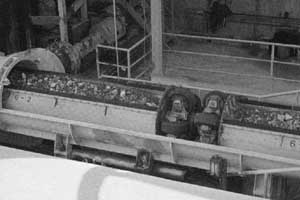
Sumitomo's 'Capsule Liner' system in operation in Tochigi. Shown are a pair of capsules loaded with limestone (Source: Sumitomo / Mining Technology).
Research into PCP was conducted in Japan during the 1960s [17], although it is not known if any significant progress resulted from this research. Transprogress technology was redesigned for use in a system designed to move limestone for the Sumitomo Cement Company. The system conveyed limestone 3.2km between a mine and a cement plant in Tochigi Pref., near Kuzuu City. Twin 1m diameter pipelines were constructed along the alignment of a disused railway line. First developed in 1981, it was opened in April 1983. It continues to operate, moving 2 million tons annually. Each capsule conveys 1.6 tons, capsules operating in trains of three [18].
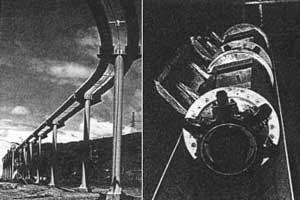
Airapid system in operation at Muroran Steel Works. A section of elevated pipeline can be seen (left), and capsules (right) (Source: Airapid).
Tubexpress based technology was implemented by the Nippon Steel Corporation, in association with logistics specialist Daifuku. Four test systems were constructed by Nippon / Daifuku [17]:
- (a) 200mm diameter 110m length,
- (b) 400mm diameter 370m long system to test suitability for moving automobile parts,
- (c) 600mm diameter, 323m long pipeline system to reliability and durability of materials used within the system,
- (d) 900mm diameter 540m length system to investigate heavy loading.
These systems lead to the development of 'Airapid'.
The Airapid system was used to move burnt lime around the Muroran steel works [19]. Dual 61cm pipes were installed elevated 7-8m above the ground. The PCP based system transports material over a distance of 1.5km, between different parts of the steelworks. 0.24 mil tons are conveyed annually.
Both companies attempted to market the technology. Both addressed the potential for both transport of minerals and general commodity freight. Sumitomo also addressed more diverse markets such as solid waste collection [20] and the construction of tunnels (ready-mixed concrete to the tunnel's face and excavated earth for the return journey) [21]. Neither Sumitomo or Airapid is understood to have been successful, although Sumitomo continue to actively promote their technology under the name Capsule-Liner.
Incremental Improvements to the Technology and the Search for a Market
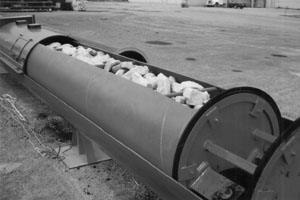
PCP capsule at Stoney Creek, Ontario, June 1988 (Source: Mike Marcu).
From the mid-1980s PCP development continued in Canada, at McMasters' University, and by Southern Ontario Technologies Inc. The work at McMasters' included investigations of vertical PCP [22]. This built on the ideas of the Alberta Research Council (see alternative propulsion). Vertical PCPs could be applied to the deep underground mining sector. Some of these ideas and applications were subsequently developed by Sumitomo.
Southern Ontario Technologies Inc (of Scarborough, Ontario, Canada) with Mike Marcu, Tom Dell, Bob Little, John Wong, and Tom Edward, developed a series of PCP prototypes, for application to bulk mineral movements [23/12]. These effectively continued the development of Romanian technology. Much of the work focused on reducing maintenance requirements of PCP (including aspects of propulsion, rolling, polymer wheels, automation, and endurance). For example, designing a new wheel cluster that is theoretically capable of remaining in use for 20 years without stopping. The first prototype PCP in Canada was opened in June 1988 in Stoney Creek, Ontario, for the movement of crushed rock. Pipelines were 40 inches in diameter. Each capsule had a capacity of 10 tonnes, the greatest capacity for a single capsule of any system in the world. The individuals involved remain active in the promotion of PCPs.
Notes
- Haussmann, G., (1970), 'Experience gaining during the second construction stage of Hamburg large-sized tube pneumatic dispatch system', Fordern und Heben, Vol.20, no.17, pp.3-6, January, in German; and Hecks, Fredrichs, J., Eske, W., (1969), 'Die Hamburger Grossrohrpost', Verlag fur Angewandte Wissenchaften GmbH, Baden-Baden, in German.
- Bahke, E., (1982), Pipelines were only the beginning - modern structural design for freight pipelines, Journal of Pipelines, 2, 133-147.
- Round, G., (1992), Pneumatic Capsule Pipeline Systems - A short history and state-of-the-art, Bulk Solids Handling, Vol 12, no. 1, February, p67-72.
- Carstens, M., (1970), 'Analysis of a Low-speed Capsule-Transport Pipeline', Hydrotransport 1: Warwick, BHRA.
- Vance, L., Mattson, P., (1994), Tube Transportation, US Dept of Transportation, Volpe National Transportation Systems Center, Feb, [summary cached text].
- Simper, J., Baker, P., (1975), 'Pneumatic Pipeline Capsule Systems - The Future Potential', Pneumotransport 2, Guildford, BHRA, Cranfield.
- Fidler, J., (1973), 'Pneumatics can be used to dispose of your firm's waste', The Engineer, 20th Sept, pp.68-71.
- Baker, P., Harwrych, J., (1982), Pneumatic Capsule Pipeline System Reserch and Development in the UK, Journal of Pipelines, 2, 237-249.
- Butler, P., (1978), 'The cost of sending material in capsules through the pipeline', The Engineer, 6th Apr, pp.62-63.
- Jvarsheishvili, A. G., (1981), Pneumo-capsule pipelines in USSR, Journal of Pipelines, 1, 109-110.
- Alexandrov, A., (1978), 'Pneumatic Pipeline Container Transportation of Goods (Transprogress System)', Pneumotransport 4, California, BHRA.
- Marcu, M., (2000 and 2005), correspondence with author.
- Institute Research Office, (1979), Transportation of grain by pipeline and other methods; a preliminary response to 1979 HJR 61, an official docuent presented to the 1979 Montana Legislature, Montana State University, Bozeman.
- Butler, T., Atkins, W., Jacobs, B., Veasey, D., (1989), Commercial Viability and Potential Market for Pneumatic Capsule Pipelines, in Freight Pipelines - proceedings of the 6th International Symposium on Freight Pipelines, eds Liu, Round.
- Van der Kroonenberg, H. H., (1982), The development of capsule transport in the Netherlands, Journal of Pipelines 2, 251-259.
- Vlasak, P., (1996), Transverse Fororces Acting on Cylindrical Capsule Conveyed by Liquid in a Pipe, Hydrotransport 13, p793-806, BHR Group.
- Yanaida, K., (1982), Capsule Pipeline Research in Japan, Journal of Pipelines, 2, 117-131.
- Sumitomo Metal Industries, (undated), Mining Mass Transportation, Mining Technology, [cached text].
- Nippon Steel Corporation, Daifuku Machinery Works Ltd, (Undated), Airapid, Capsule-Tube Transport System - Promotional Information, [cached text].
- Mutsuta, A., Kosugi, S., (1989), A feasibility Study on a collection-transportation system of municipal solid wastes by pipelines a newly developed urban district, in Freight Pipelines - proceedings of the 6th International Symposium on Freight Pipelines, eds Liu, Round.
- Kosugi, S., (2000), 'Pneumatic Capsule Pipelines in Construction Industry', 2nd International Symposium on Underground Freight Transportation by Capsule Pipelines and Other Tube/Tunnel Systems.
- Latto, B., Chow, K., (1982), 'Transport of Capsules in Vertical Pipelines', Journal of Pipelines, 3, pp109-122.
- Marcu, M., (1992), Pneumatic Capsule Pipeline System for Bulk Materials Transport, Bulk Solids Handling, Vol. 12, no.1, February, p77.